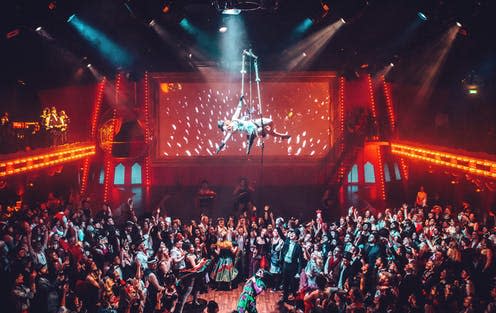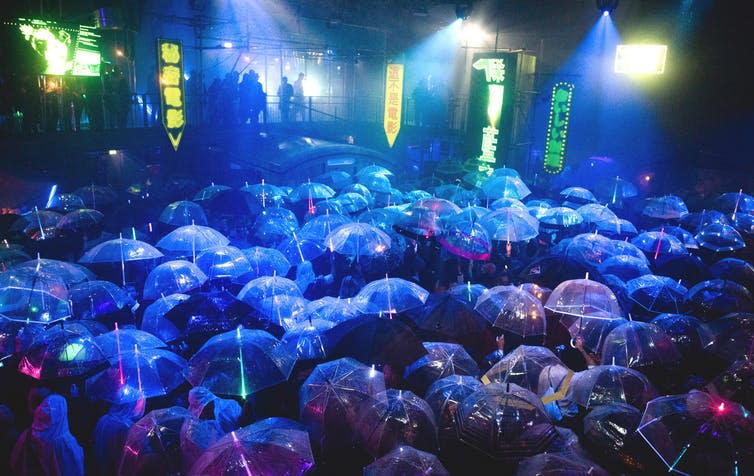Disney teams up with Secret Cinema – watching movies will never be the same again

Disney’s recent deal with the immersive experience company Secret Cinema signals a new era for the cinema industry. New film titles from the Disney portfolio will be staged as immersive experiences in London by Secret Cinema later in 2020 before being exported to America.
Secret Cinema is renowned for its expanded immersive cinematic worlds staged in a variety of disused warehouses and open-air locations, creating experiences that last for several hours. Costumed participants surrender their phones and interact with characters from the film the event is based on and with each other. This all leads up to an augmented screening of the film.
Trends suggest that investors see immersive experiences as a hot sector, so the economic and cultural implications of this deal for the US$160 billion (£123 billion) global sector are huge. The unique combination of Disney’s global reach and the successful track record of Secret Cinema means that this powerful partnership will shape the global direction of the immersive experience economy for years to come.
This is a sector that favours experience over product. What began in live music, festivals and sporting events has spread to all aspects of the leisure economy. Dining out, shopping and film going have all been made into engaging experiences – and the more immersive and escapist, the better.
Secret Cinema has been building its brand since 2007 when it started with small, underground and clandestine events such as for the indie film Paranoid Park in a disused railway tunnel. As the operation grew, Secret Cinema productions gradually became big box office events and they have repeatedly found themselves towards the top of the box office charts, even when staging events based around films that are over 20 years old.
Secret Cinema has also been pioneering large-scale event-led distribution strategies for new releases, from a production of Ridley Scott’s 2012 film Prometheus to coincide with the movie’s premiere, to most recently (in 2017) a staging of Park Chan Wook’s The Handmaiden. Prometheus made more money as a Secret Cinema release than it did at its IMAX premiere.
Secret Cinema has inspired numerous other companies, experience designers and immersive entertainment providers. In this domain we see a number of recent mainstream commercial offers such as the immersive Wolf of Wall Street experience and family-oriented War of The Worlds experience marketed through Virgin Experience Days. But none have reached the scale of the expanded narrative universes of Secret Cinema.
Stranger Things
Take for example its most recent production in which Secret Cinema partnered with streaming giant Netflix for a screening of highlights of its hit show Stranger Things. An audience of up to 1,200 arrived every night of the four-month run in full 1980s regalia, having engaged in an online fictional world prior to their attendance where they have been assigned an identity as a punk, a new romantic or a rocker among others.
Participants’ were invited to lose themselves in the expanded and atmospheric world of the TV series through the recreation of multiple key locations from the fictional world in a large warehouse – including sites such as the Starcourt shopping mall and different character’s houses. Following clues and uncovering secrets, every single participant takes away a different experience.
Other Secret Cinema outdoor events have included restaging Back to the Future in 2015, complete with the famous DeLorean car, and a large-scale experience based around Baz Luhrmann’s Romeo + Juliet in the summer of 2018 in a West London park. This brought in 5,000 participants each night to play a part as members of the warring Montague and Capulet families in an expanded “Verona beach” set.

In Bladerunner (2017) an internal weather system was created so continuous rain would fall on crowds inside the warehouse setting, with participants purchasing umbrellas and raincoats to stay dry.
Selling experience
As you can imagine, these experiences generate huge revenues. This is in part achieved through a graded pricing structure that enables higher levels of access and further augmentations into the experience. The more that you pay, the deeper layers of experience that you peel back. Tickets can range from an entry level £49 to £175 for a fuller VIP experience.
Once in their chosen world, participants are given plenty of opportunities to spend more money, buying costumes and a range of other merchandise including themed food and drink. In 28 Days Later (2016), all participants were instructed to arrive wearing hospital scrubs in preparation to enter a staged quarantine facility. Those that didn’t were marched by costumed armed police officers to a kiosk to purchase the appropriate attire.
This is where the Disney partnership fits so well with the next iteration of Secret Cinema. Disney has always been the master of merchandising since its own beginnings with the commodification of the Mickey Mouse mascot in the 1930s. And of course, as far back as the 1970s, Disney World offered a form of branded “experience” to millions around the world.
In 2016, we forecast that immersive cinema would change the future of film, and the latest partnership between Disney and Secret Cinema is a big step along that road. While we await the finer details of the Disney agreement – including which titles are to receive the Secret Cinema treatment – we can only speculate about the bigger picture and the next opportunities for developments in this evolution.
So what’s next?
We speculated in an earlier piece for The Conversation that we would start to see films made specifically for immersive exhibition, taking increasingly spectacular forms. Now technology is catching up to make this a reality. In film production, we see the increasing use of “virtual production”, where on-screen film environments can now be replicated in scale and detail in both virtual reality and physical spaces (as in immersive film experiences).
So we’re set to enter a future where you can first watch a film on a screen and later walk into an exact physical or virtual replica of that film. This is the future of film audience experience – and one in which we can expect Secret Cinema to continue to be the pioneers.
This article is republished from The Conversation under a Creative Commons license. Read the original article.

Sarah Atkinson has received funding from AHRC/EPSRC, Innovate UK and SSHRC.
Helen W. Kennedy has received funding from AHRC/EPSRC for Immersive Experience Project: XR Circus, Innovate UK and SSHRCC.

